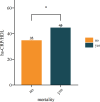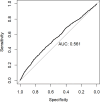hs-CRP/HDL-C can predict the risk of all cause mortality in cardiovascular-kidney-metabolic syndrome stage 1-4 patients
- PMID: 40276550
- PMCID: PMC12018248
- DOI: 10.3389/fendo.2025.1552219
hs-CRP/HDL-C can predict the risk of all cause mortality in cardiovascular-kidney-metabolic syndrome stage 1-4 patients
Abstract
Background: The precise function of the hs-CRP/HDL-C ratio in forecasting the long-term mortality risk of patients with stages 1-4 of Cardiovascular-Kidney-Metabolic (CKM) syndrome remains inadequately delineated. This study investigates the potential correlation between the hs-CRP/HDL-C ratio and long-term mortality risk in individuals with CKM syndrome stages 1-4.
Methods: This prospective cohort study utilises data from the China Health and Retirement Longitudinal Study (CHARLS) project, encompassing 6,719 people who satisfied stringent criteria. We developed three Cox proportional hazards regression models to investigate the potential relationship between the hs-CRP/HDL-C ratio and long-term mortality risk in patients with CKM stages 1-4. We employed Restricted Cubic Spline (RCS) curves for analysis to identify any potential nonlinear correlations. Furthermore, we performed Receiver Operating Characteristic (ROC) curve analysis to evaluate predictive performance and identify the appropriate cut-off value. To enhance the research findings, we conducted a stratified analysis to investigate the influence of various sociodemographic factors on this association.
Results: In individuals with CKM syndrome stages 1-4, the 10-year incidence of all-cause mortality was 14.1%. Upon controlling for additional potential confounding variables, the outcomes of the Cox proportional hazards regression model distinctly demonstrated a statistically significant linear positive association between the hs-CRP/HDL-C ratio and the long-term mortality risk in patients. For each quartile increase in the hs-CRP/HDL-C ratio, the probability of poor outcomes (i.e., mortality) escalated by 15% (Hazard Ratio, HR = 1.15, 95% Confidence Interval, CI: 1.09-1.22, p-value < 0.001). Moreover, the integration of the hs-CRP/HDL-C ratio into the baseline risk prediction model, with all pertinent factors thoroughly adjusted, markedly enhanced the model's predictive capacity, facilitating a more precise assessment of long-term mortality risk in patients with CKM syndrome stages 1-4.
Conclusion: This study identified a positive linear association between the hs-CRP/HDL-C ratio and long-term mortality risk in patients with stages 1 to 4 of CKM syndrome. This remarkable discovery not only offers a crucial reference for enhancing early individualised treatment options but also greatly aids in the early identification of patients with poor prognoses, hence presenting a novel perspective for improving clinical management pathways for these individuals.
Keywords: CHARLS; cardiovascular-kidney-metabolic syndrome; high-density lipoprotein cholesterol; high-sensitivity C-reactive protein; mortality.
Copyright © 2025 Han, Guo, Zhang and Zheng.
Conflict of interest statement
The authors declare that the research was conducted in the absence of any commercial or financial relationships that could be construed as a potential conflict of interest.
Figures







References
-
- Prenner SB, Mulvey CK, Ferguson JF, Rickels MR, Bhatt AB, Reilly MP. Very low density lipoprotein cholesterol associates with coronary artery calcification in type 2 diabetes beyond circulating levels of triglycerides. Atherosclerosis. (2014) 236:244–50. doi: 10.1016/j.atherosclerosis.2014.07.008 - DOI - PMC - PubMed
MeSH terms
Substances
LinkOut - more resources
Full Text Sources
Medical
Research Materials
Miscellaneous

